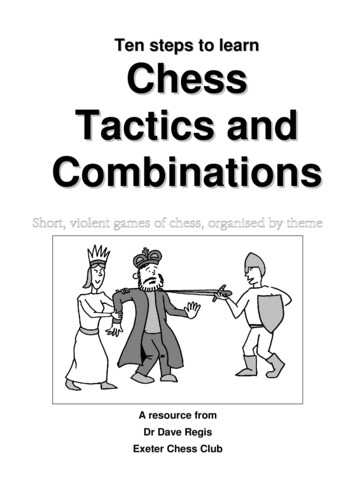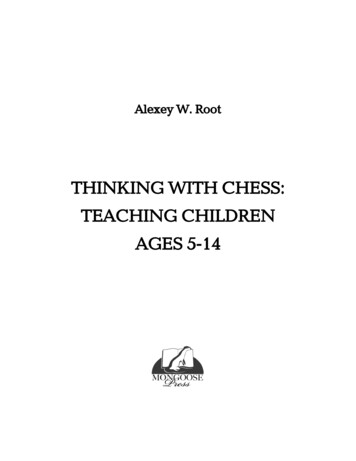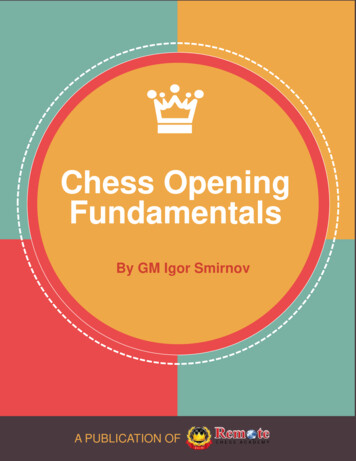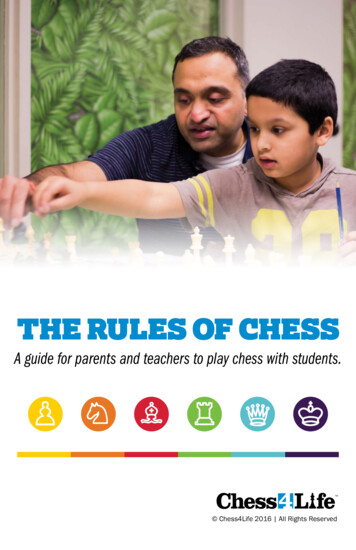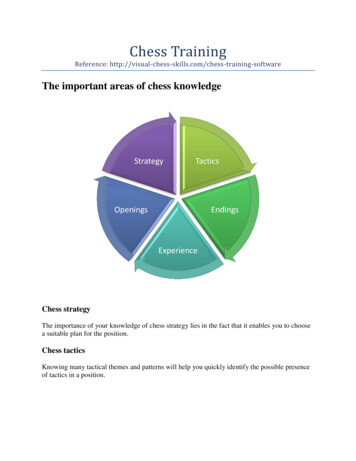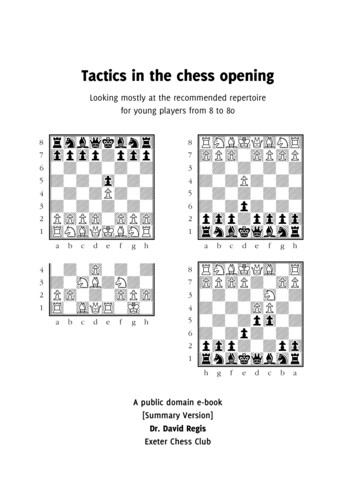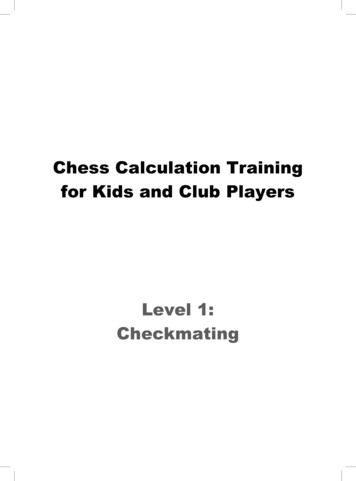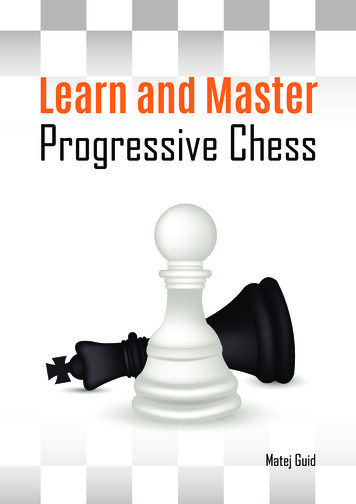
Transcription
POPOPOSNAQJBMR
Contents1 Mates91.19Mate in 1 . . . . . . . . . . . . . . . . . . . . . . . . . . . . . . . . . . .2 Mate in Two622.1White to Move #2 . . . . . . . . . . . . . . . . . . . . . . . . . . . . . .622.2Combinations #2 (451-3514) . . . . . . . . . . . . . . . . . . . . . . . . .882.3Combinations #2 (3515-3718) . . . . . . . . . . . . . . . . . . . . . . . . 6003 Mate in three3.1636Combinations #3 (3719-4462) . . . . . . . . . . . . . . . . . . . . . . . . 6364 600 Miniature games7624.1f3 (f6) combinations (4463-4562) . . . . . . . . . . . . . . . . . . . . . . . 7634.2g3 (g6) combinations (4563-4662) . . . . . . . . . . . . . . . . . . . . . . 7724.3f3 (f6) combinations (4463-4562) . . . . . . . . . . . . . . . . . . . . . . . 7814.4f2 (f7) combinations (4763-4862) . . . . . . . . . . . . . . . . . . . . . . . 7914.5g2 (g7) combinations (4863-4962) . . . . . . . . . . . . . . . . . . . . . . 7994.6h2 (h7) combinations (4963-5062) . . . . . . . . . . . . . . . . . . . . . . 8104.7600 Games - Diagrams . . . . . . . . . . . . . . . . . . . . . . . . . . . . 8195 Simple endgames69215.1White draws (5063-5104). . . . . . . . . . . . . . . . . . . . . . . . . . 9215.2White wins (5105-5206) . . . . . . . . . . . . . . . . . . . . . . . . . . . 930Polgár sisters’ tournament-games combinations (5207-5334)6.1949Polgár sisters’ combinations . . . . . . . . . . . . . . . . . . . . . . . . . 949
5334 Problems, Combinations & Games7Mate in two8 SolutionsCONTENTS9729749 Biography of László Polgár118210 Bibliography1183
ForewordThere are more than 5.000 problems in25 moves) will help you to avoid errors inthis book. Most of them can be solvedgame opening, and it will improve yourwithin a few minutes. There are few booksarsenal for attacking the king. Children arecontainingandmore interested in short games, and theyendgames which are not only easy to solvecan concentrate on them better than onbut elegant and instructive as well. Andlong ones. The two-move miniature gamesthere are even fewer that offer a sufficient(maximum number of pieces: 7) are notnumber for regular and intensive trainingdifficult, but they are enjoyable, and makeover a relatively long period. With thisit possible to proceed to more challengingbook, I would like to provide some help forchess problems. They may also inspire you tothose who are learning the game alone, andstudy the literature dealing with problems,for parents and coaches too.or even to create your own chess problems.chessproblems,gamesA word of guidance before we start.This book draws on my private collec-First, learn the names and the colors of thetion of five thousand chess books, and mysquares on the chessboard. Never move thearchives of periodicals going back 150 years.pieces while solving a problem. Solving theI have also used the experience gained in theproblems in this book may result in a con-training of my three daughters – Olympicsiderable improvement in your tactics, logic,gold medallists, Oscar-award winners, hold-concentration and imagination, and will alsoers of several Guinness records, championsbe a source of motivation – nothing is asof the world, for many years first andencouraging as success and achievement.second in the world ranking – and duringYou can use your new knowledge in playingmy fifteen year activity as a chess tutor inwith partners and in tournaments too.extracurricular classes at various schools.Studying the miniature games (maximumIn addition to studying the book, begin-
5334 Problems, Combinations & Gamesners who may wish to become tournamentI wish to thank Könemann Verlag forchess players should play every day – evenmaking it possible to publish a chessagainst a chess computer if they do not havebook of so wide a scope; Kulturtradea regular partner. And the repeated prob-for editing the manuscript; my daughterslems in the book will repay repeated solvingfor their help in professional matters; andand study. The book aims to strengthenmy wife for her help with technical problems.the positive skills and discipline needed forcompetition in chess (and any other field) –Budapest, 1994but above all it aims to give pleasure.László PolgárApart from the foreword and the chapter”Key to symbols”, the following 1000 pagesare written in international chess terms,and thus the book can be read in anycountry by those who wish to improvetheir knowledge. The chapters containingproblems and combinations might be usefulfor setting up problem-solving contests. Theproblems figuring in this collection cover thehistory of chess literature from 1140 to thepresent. There are problems by Pál Benkö,the international grandmaster, created especially for this collection, and there are 125combinations from the tournament gamesof the Polgár sisters. This book is primarilyintended for beginners and amateurs, fromthe basic level to master candidate (2.200Elo points), and can be enjoyed by playersof all ages.
Introductionby Bruce Pandolfinirelated problems, six large diagrams perChess, as this László Polgár volume ispage. Examples in a section are subdividedtitled, is perhaps the most comprehensivefurther, based on which player, White orbook ever conceived on the art of checkmate.Black, moves first. The text is minimal, butIt contains some 5.334 examples, primarilythe presentation, is clear enough for evendealing with mate, mating attacks. Orbeginning students. Anyway, it’s well knownforced endgame wins. Mr. Polgar. the fatherthat the best chess instruction is largelyand personal chess trainer of the renownedvisual.Polgar sisters of Hungary, hjs prosided over1.100 pages of brilliantly organized didacticOf the initial 4.462 problems here. 306and practical paradigms to equip the readerare mates in one move; 3.411 are mates inwith the weapons needed to play powertwo moves (the attacker plays, the defenderchess.responds, the attacker mates): and 743 aremates in three moves (the attacker plays,Here reconstructed is the path followedthe defender responds, the attacker plays aby Zsusza, Zsofia and Judit Polgár in theirsecond move, the defender responds again,meteoric climb to the top of the chessand the attacker gives mate). Some of thesepantheon. It is said that each sister workedmates have been composed for instructionalthrough and played out similar groups ofpurposes, but others have been taken fromtheir father’s carefully chosen and arrangedreal chess games. Each of these sections isexamples, until vital patterns and schemeslarge enough to constitute a book in itself,became second nature, very like the wayand the chapter on ”mates in two” alonemusic students master linger exercises.could enrich several years of study.The format is beautifully logical, as withFollowing the mating problems is a phe-all grand strategies. There are sections ofnomenal section with 600 miniature games
5334 Problems, Combinations & Games(examples 4.463-5.062). all the moves of ev-masters and world class players throughoutery game given in figurine algebraic notationtheir tournament and match careers. Thefor easy use. (A symbol of the moving piecesolutions and pertinent factual informationappears instead of an abbreviating letter, so(place, date, and name of the Polgir oppo-anyone can follow in any language.) Eachnent) are found in the concluding segment,game begins with the opening moves guidingcontaining all the answers for the book’sthe reader to a pivotal moment. A diagram5.334 examples. The very last diagram, byprompts the reader to find the next move,the way. is a bonus problem created by thesuggested by the subsection in which themiddle sister, Zsofia Polgár, the placement ofgame appears. For instance, if a game isthe pieces tracing the outline of a rook! Thein the f3 section (examples 4.463-4.562),tome ends with a short biographical sketchthe winning move must be made to theof the author and a helpful bibliographysquare f3, if it is Black’s move, or f6, if itof sources of the problems not personallyis White’s. What better clue could be givendeveloped by Lazlo Polgár.than an indication of the destination square?If you’re new to the game, you can beginNext is a chapter of basic endgame posi-at page one and proceed step by step. Chesstions (5.063-5.206), each of just a few piecesconveniently provides a pithy introductionand mainly concluded by promoting a pawnto the moves and rules, for some reasoninto a queen, important patterns becauseomitted from most tactical chess books,many games reduce to a situation where thelivenextra queen assists checkmate.reviewing this introduction before tacklingexperiencedplayersmightpreferthe actual problems. Another approach, justFrom this Olympian preparation, the bookas viable, is to focus on particular sectionsmoves into its final chapter (examples 5.207-or themes for special study, since each5.333). consisting of short tactical gamesgrouping, though part of a logical whole, isplayed by the Polgár sisters themselves.also a self-contained unit.These contests all illustrate incisive attacksand winning stratagems utilized by Zsuzsa,You might decide not to work directly fromZsofia, or Judit in their confrontations withthe book but to set up problems on a chess-
5334 Problems, Combinations & Gamesboard. If so. first try to solve them withoutmoving the pieces. This develops analytic vision and improves overall ability. Whateveryour level of skill or interest, you’ll find thatLászló Polgar’s Chess offers an abundance of instruction and pleasure and provides a superb foundation for any chess library.
Key to Simbols
Chapter 1Mates
1.1 Mate in 15334 Problems, Combinations & 00Z0Z0Z0ZZ0Z0Z0Z00APZ0Z0ZZ0JRZ0Z0abcdefgh
1.1 Mate in 15334 Problems, Combinations & Z0M00Z0A0Z0ZZ0ZBZ0Z00Z0Z0ZPOZ0Z0Z0ZKabcdefgh
1.1 Mate in 15334 Problems, Combinations & Z040Z0Z0Z0Z3ZBZ0Z0Z02POPZ0Z0Z1Z0J0Z0ZRabcdefgh8
1.1 Mate in 15334 Problems, Combinations & 0M0Z0Z00Z0Z0Z0ZZ0Z0Z0Z00Z0Z0Z0ZZ0S0Z0ZKabcdefgh
1.1 Mate in 15334 Problems, Combinations & M040Z0Z0Z0Z3Z0Z0Z0Z020A0Z0Z0Z1Z0J0Z0Z0abcdefgh8
1.1 Mate in 15334 Problems, Combinations & 0Z0Z0Z00Z0Z0Z0ZZ0Z0Z0Z00Z0Z0Z0ZZ0Z0Z0J0abcdefgh
1.1 Mate in 15334 Problems, Combinations & Z040Z0J0Z0Z3Z0Z0Z0Z020Z0Z0Z0Z1Z0Z0Z0Z0abcdefgh8
1.1 Mate in 15334 Problems, Combinations & Z040Z0Z0J0Z3Z0Z0Z0Z020Z0Z
23.06.2016 · the book but to set up problems on a chess-5334 Problems, Combinations & Games board. If so. first try to solve them without moving the pieces. This develops analytic vi-sion and improves overall ability. Whatever your level of skill or interest, you’ll find that Laszl o Polgar’s Chess offers an abun- dance of instruction and pleasure and pro-vides a superb foundation for any chess .
